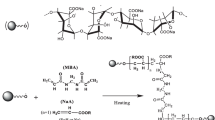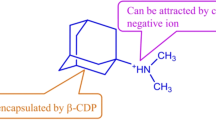Abstract
Various pH-sensitive sequential interpenetrating polymer network (IPN) hydrogels were prepared by introducing poly (vinyl alcohol) (PVA) hydrogel into Poly (aspartic acid) (PASP) hydrogel by freeze-thawing treatment to obtain a novel drug delivery system to the intestine. The structure and the morphologies of the prepared hydrogels were studied by Fourier Transform Infrared Spectroscopy (FTIR) and scanning electron microscopy (SEM). The thermal behavior and crystallinity of the hydrogels were characterized by differential scanning calorimetry (DSC) and X-ray diffraction (XRD). Their pH-sensitive properties moreover were studied and the results revealed that both PASP hydrogel and IPN hydrogels exhibited excellent pH-sensitivity. Furthermore, the controlled drug release properties of the hydrogels were also evaluated and results indicated that by increasing the PVA fraction in the IPN hydrogel, the release of Naproxen sodium was improved. These results show that the IPN hydrogels could be a suitable carrier for site-specific drug delivery in the intestine.






Similar content being viewed by others
References
Mehr MJZ, Pourjavadi A, Salimi H, Kurdtabar M (2009) Protein- and homo poly (amino acid)-based hydrogels with super-swelling properties. Polymer Adv Tech 20:655–671
Ananta M, Brown RA, Mudera V (2012) A rapid fabricated living dermal equivalent for skin tissue engineering: an in vivo evaluation in an acute wound model. Tissue Eng Part A 18:352–361
Singh B, Pal L (2011) Radiation crosslinking polymerization of sterculia polysaccharide–PVA–PVP for making hydrogel wound dressings. Int J Biol Macromol 48:501–510
Ambrosio L, Santis RD, Nicolais L (1998) Composite hydrogels for implants. Proc IME H J Eng Med 212:93–99
Delair T (2011) In situ forming polysaccharide-based 3D-hydrogels for cell delivery in regenerative medicine. Carbohydr Polymer 87:1013–1019
Li SF, Yang YJ, Li HB, Yang XL, Xu HB (2007) pH-responsive semi-interpenetrating networks hydrogels of poly(acrylic acid-acrylamide-methacrylate) and amylase. J Appl Polymer Sci 106:3792–3799
Han J, Wang K, Yang DZ, Nie J (2009) Photopolymerization of methacrylated chitosan/PNIPAAm hybrid dual-sensitive hydrogels as carrier for drug delivery. Int J Biol Macromol 44:229–235
Lai FK, Li H (2011) Transient modeling of the reversible response of the hydrogel to the change in the ionic strength of solutions. Mech Mater 43:287–298
Ali AE, AlArifi A (2009) Characterization and in vitro evaluation of starch based hydrogels as carriers for colon specific drug delivery systems. Carbohydr Polymer 78:725–730
Rosalia R, Cammn AL, Angel C (2003) Cationic cellulose hydrogels: kinetics of the cross-linking process and characterization as pH/ion-sensitive drug delivery systems. J Contr Release 86:253
Li C, Luo GF, Wang HY (2011) Host-guest assembly of ph-responsive degradable microcapsules with controlled drug release behavior. J Phys Chem C 115:17651–17659
Liu CH, Chen YQ, Chen JG (2010) Synthesis and characteristics of pH-sensitive semi-interpenetrating polymer network hydrogels based on konjac glucomannan and poly (aspartic acid) for in vitro drug delivery. Carbohydr Polymer 79:500–506
Yang J, Wang F, Fang L, Tan TW (2006) Synthesis, characterization and application of a novel chemical sand-fixing agent-poly (aspartic acid) and its composites. Environ Pollut 149:125–130
Young SJ, Jing L, Kim JH (2008) Dye adsorption characteristics of alginate/polyaspartate hydrogels. J Ind Eng Chem 14:726–731
Yin LC, Ding JY, Zhang J, He CB, Tang C, Yin CH (2010) Polymer integrity related absorption mechanism of superporous hydrogel containing interpenetrating polymer networks for oral delivery of insulin. Biomaterials 31:3347–3356
Athawale WD, Kolekar SL, Raut SS (2003) Recent developments in polyurethanes and poly (acrylates) interpenetrating polymer networks. J Macromol Sci Polymer Rev 43:1–26
Stauffer SR, Peppast NA (1992) Poly(vinyl alcohol) hydrogels prepared by freezing-thawing cyclic processing. Polymer 33:3932–3936
Wen X, Cao XL, Yin ZH, Wang T, Zhao CS (2009) Preparation and characterization of konjac glucomannan-poly (acrylic acid) IPN hydrogels for controlled release. Carbohydr Polymer 78:193–198
Holloway JL, Lowman AM, Palmese GR (2010) Mechanical evaluation of poly (vinyl alcohol)-based fibrous composites as biomaterials for meniscal tissue replacement. Acta Biomater 6:4716–4724
Yang H, Horii F (2008) Investigation of the structure of poly (vinyl alcohol)-iodine complex hydrogels prepared from the concentrated polymer solutions. Polymer 49:785–791
Ruiz J, Mantecón A, Cádiz V (2001) Synthesis and properties of hydrogels from poly (vinyl alcohol) and ethylenediaminetetraacetic dianhydride. Polymer 42:6347–6354
Kulkarni RV, Sreedhar V, Mutalik S, Shetty CM, Sa B (2010) Interpenetrating network hydrogel membranes of sodium alginate and poly(vinyl alcohol) for controlled release of prazosin hydrochloride through skin. Int. J. Biol. Macromol 47:520–527
Wei L, Cai CH, Lin JP, Chen T (2009) Dual-drug delivery system based on hydrogel/micelle composites. Biomaterials 30:2606–2613
Liu MM, Su HJ, Tan TW (2012) Synthesis and properties of thermo- and pH-sensitive poly(N-isopropylacrylamide)/polyaspartic acid IPN hydrogels. Carbohydr Polym 87:2425–2431
Zhang XZ, Wu DQ, Chu CC (2004) Synthesis, characterization and controlled drug release of thermosensitive IPN-PNIPAAm hydrogels. Biomaterials 25:3793–3805
Zhao Y, Kang J, Tan TW (2006) Salt-, pH- and temperature-responsive semi-interpenetrating polymer network hydrogel based on poly (aspartic acid) and poly (acrylic acid). Polymer 47:7702–7710
Tang QW, Sun XM, Li QH, Wu JH, Lin JM (2009) Fabrication of a high-strength hydrogel with an interpenetrating network structure. Colloid Surf Physicochem Eng Aspect 346:91–98
Zhang JT, Bhat R, Jandt KD (2009) Temperature-sensitive PVA/PNIPAAm semi-IPN hydrogels with enhanced responsive properties. Acta Biomater 5:488–497
Saini R, Bajpai AK (2005) Preparation and characterization of biocompatible spongy cryogels of poly (vinyl alcohol)-gelatin and study of water sorption behavior. Polymer Int 54:1233–1242
Yang XM, Zhu ZY, Liu Q, Chen XL, Ma MW (2008) Effects of PVA, agar contents, and irradiation doses on properties of PVA/ws-chitosan/glycerol hydrogels made by g-irradiation followed by freeze-thawing. Radiat Phys Chem 77:954–960
Hua SB, Ma HZ, Li X, Yang HX, Wang AQ (2010) pH-sensitive sodium alginate/poly (vinyl alcohol) hydrogel beads prepared by combined Ca2+ crosslinking and freeze-thawing cycles for controlled release of diclofenac sodium. Int J Biol Macromol 46:517–523
Wang Q, Zhang JP, Wang AQ (2009) Preparation and characterization of a novel pH-sensitive chitosan-g-poly(acrylic acid)/attapulgite/sodium alginate composite hydrogel bead for controlled release of diclofenac sodium. Carbohydr Polymer 78:731–737
Mandal BB, Mann JK, Kundu SC (2009) Silk fibroin/gelatin multilayered films as a model system for controlled drug release. Eur J Pharm Sci 37:160–171
Acknowledgments
The authors express their thanks for the supports from the Natural Science Foundation of China (21076009), the (863) High Technology Project (2008AA062401) and the Programs for New Century Excellent Talents in the University (NCET-100212) and the Project sponsored by SRF for ROCS, SEM (LXJJ2012-001).
Author information
Authors and Affiliations
Corresponding author
Rights and permissions
About this article
Cite this article
Liu, M., Wang, L., Su, H. et al. pH-sensitive IPN hydrogel based on poly (aspartic acid) and poly (vinyl alcohol) for controlled release. Polym. Bull. 70, 2815–2827 (2013). https://doi.org/10.1007/s00289-013-0990-4
Received:
Revised:
Accepted:
Published:
Issue Date:
DOI: https://doi.org/10.1007/s00289-013-0990-4




